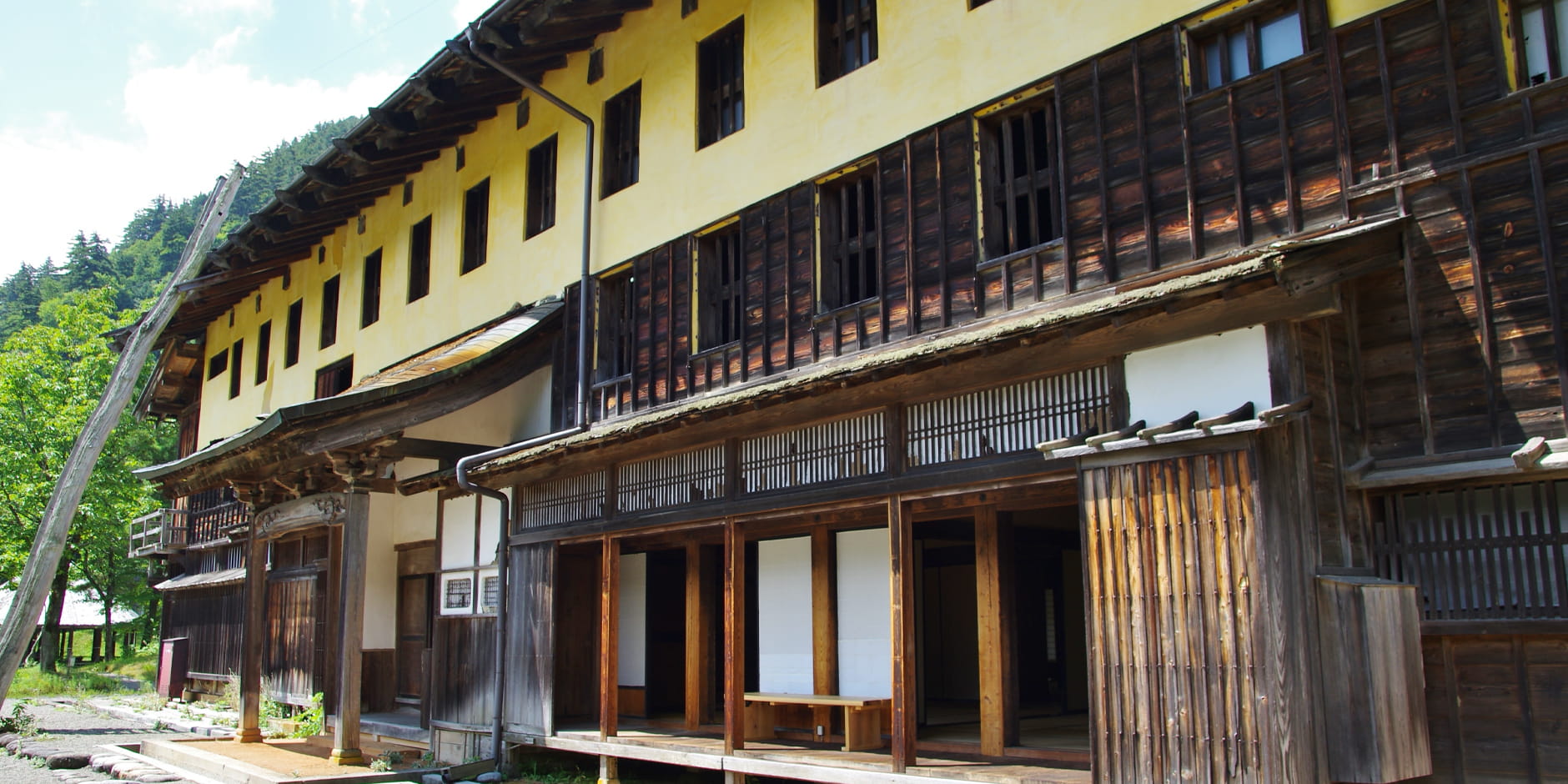


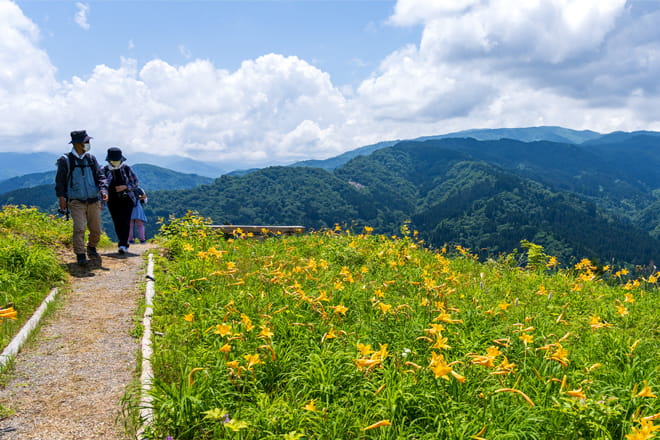


Mt. Hakusan is covered in snow for half the year. The abundant amounts of water that result from the snow melting have long blessed the people living in its watershed, so much so that locals say that a white Mt. Hakusan means a good rice harvest the following year. Mt. Hakusan is said to have been venerated in nature worship for centuries, both as an agricultural deity for its role in providing water essential for life and as a sea deity for nourishing the ocean and serving as a landmark for boats on the water.
After Taicho (682–767), a Buddhist monk from Echizen (part of present-day Fukui), supposedly founded a temple on Mt. Hakusan in 717, Shinto-Buddhist syncretism and mountain asceticism emerged on the mountain, spreading throughout Japan. Mt. Hakusan has thus served as the stage for various histories—Shinto, Buddhist, and human. Against this backdrop, the mountain has also supplied the land and the Sea of Japan with abundant nutrients, consistently bringing blessings to the region, generation after generation. Even now, the people living in Mt. Hakusan’s watershed pray to the mountain, show their thanks and reverence to Mother Nature, and cultivate skills needed to thrive there.
This three-day, two-night adventure covers a vast area from the sacred natural site of Mt. Hakusan to the Sea of Japan and provides valuable opportunities to realize how Mt. Hakusan’s life-sustaining waters link together the local way of life and cuisine.
Hakusan’s brand of agricultural, forestry, and fishery products encompasses ingredients and foodstuffs unique to the area, including Hime rice, wild red sea bream from Mikawa, and Hakusan Kikusake alcohol. You’ll also find foods listed on the 100-Year Foods list compiled by the Agency for Cultural Affairs, such as Shiramine firm tofu and kamashi-iriko, a traditional paste-like dessert. On this tour, you can indulge in various regional flavors, from long-cultivated wasabi and nagashi somen noodles channeled down bamboo chutes by the same spring water used to grow wasabi to traditional dishes like Ho’onko ryori, a kind of Buddhist cuisine served during memorial services, that showcase local ingredients.
This trip takes you through the nature, history, culture, and cuisine born from the lay of the land—from Mt. Hakusan to the sea—with an emphasis on the mountain’s life-sustaining waters. Familiarize yourself with the abundant nature brought forth by Mt. Hakusan’s heavy snowfall, the mountain’s intertwined Shinto, Buddhist, and human histories, and the varied traditions that flow from the mountain to the Sea of Japan.
Reservation Website URL:
Contact:
11:00 a.m. | Arrive at Kanazawa StationHave a Hakusan Tedorigawa Geopark rice bowl for lunch at Sushi Mihama in MikawaVisit the Hakusan Mikawa Springs, one of the top 100 most significant bodies of water of the Heisei era (1989-2019) chosen by the Ministry of the Environment, and enjoy some spring water and snacks like chilled fruitsTour the Yoshida Shuzoten brewery and try samples
Established in 1870 at the foot of the sacred Mt. Hakusan, Yoshida Shuzoten has been brewing sake in the alluvial fan of the Tedori River for over 150 years. Full of personality, the brewers pursue delicious, enjoyable sake while embodying the spirit of “wajo ryoshu,” the production of excellent sake through harmonious brewing.
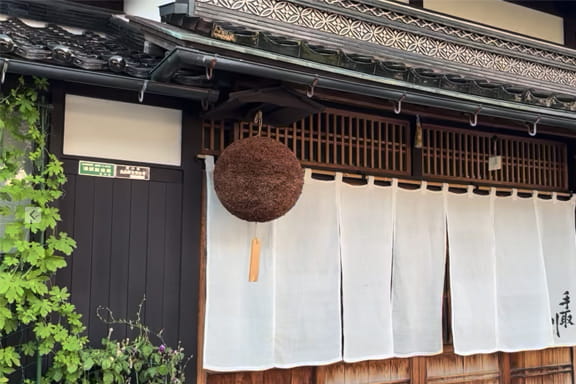
Visit and enter Shirayama Hime Jinja
Colloquially called “Shirayama-san,” Shirayama Hime Jinja reveres Mt. Hakusan as its sacred mountain and is the head shrine presiding over Japan’s roughly 3,000 Shirayama and Hakusan shrines. Mt. Hakusan itself was once called the “White Peak of Koshi (an ancient province in the present-day Hokuriku region)” and famed as a mountain long adored by people living in the Japanese capital. After entering the shrine and watching a ritualistic kagura dance be performed for the Shinto deities, follow the frontal approach shaded by ancient cedar and zelkova trees and explore the grounds beyond.
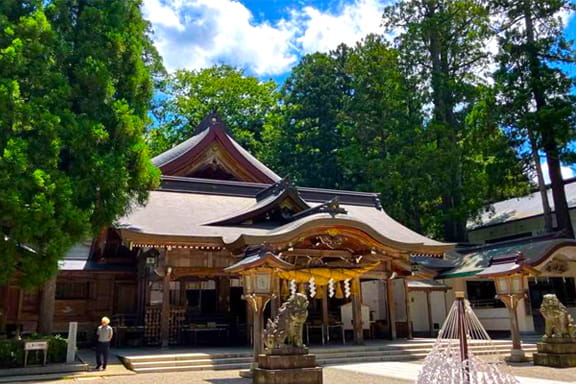
Arrive at your traditional folk-house accommodations in Shiramine (such as Nipponia Hakusan Shiramine’s Yu and Sennyomo retreats)Have dishes prepared by a local chef featuring seasonal ingredients for dinner at your accommodationsPerform and observe the Kanko Odori dance, a traditional performing art associated with Mt. Hakusan, after dinner
One of Shiramine’s traditional performing arts, the Kanko Odori dance is said to have originated thanks to the Buddhist monk Taicho, who supposedly founded a temple atop Mt. Hakusan in 717. According to legend, after Taicho headed up the mountain, local villagers, eagerly awaiting his return, went to reunite with him. When Taicho appeared before them in a divine form, the villagers were overcome with joy, inspiring them to dance. Performed during the summer Bon festival and other festive occasions, the Kanko Odori dance continues to be carefully passed down by the community and is now an Intangible Cultural Property of Ishikawa.
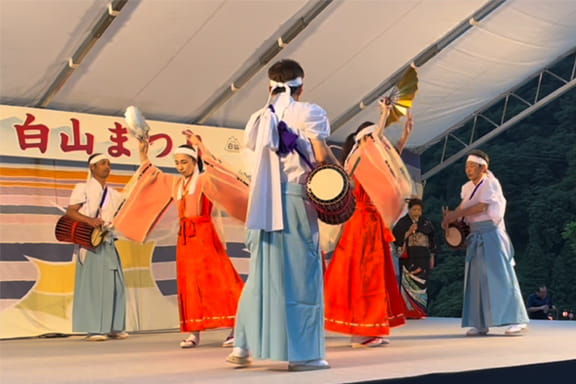
9:00 a.m. | Depart from your accommodationsWalk around Shiramine’s Important Preservation District for Groups of Traditional Buildings
During the Edo period (1603–1867), this area flourished as a hub for the eighteen villages around the base of Mt. Hakusan that were directly controlled by the shogunate government. Distinctive hamlets took shape in the narrow mountainous stretches, with buildings evolving in response to the extremely snowy climate and local trades, such as sericulture. A group of these regionally unique buildings still stands today, providing a glimpse into the history of a mountain hamlet subject to extreme natural conditions.
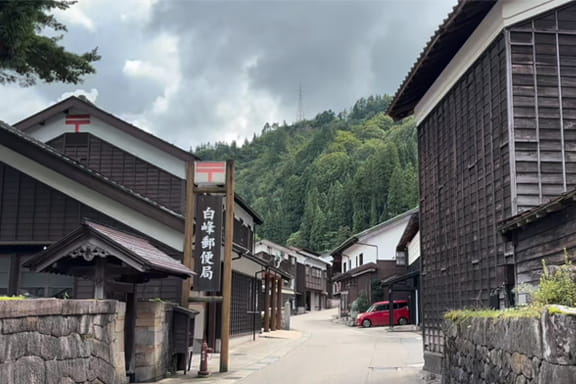
Pay homage to Buddhist representations of Mt. Hakusan’s Shinto deities at Rinsaiji
While a large number of Buddhist statues had been enshrined at the top of Mt. Hakusan for ages, they were forcibly removed from the mountain or destroyed entirely when the new Meiji government (1868–1912) mandated the separation of Shintoism and Buddhism in 1868. Concerned by this, the monks of the Buddhist temple Rinsaiji took in several statues, housing them in a hall on the premises. The bronze Eleven-Headed Kannon (a standing depiction of the bodhisattva of compassion)—an Important Cultural Property of Japan—and six other Buddhist statues, as well as a seated statue of Mt. Hakusan’s temple-founding monk Taicho, are currently on display.
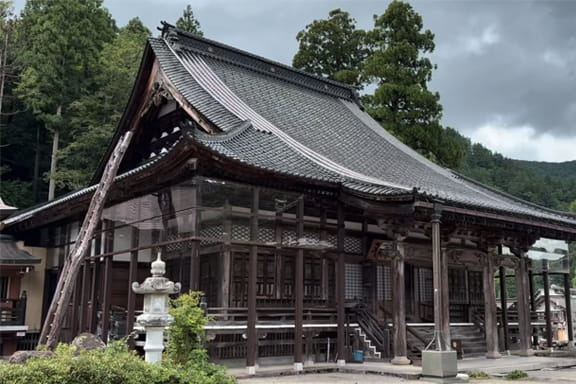
Experience cultivating wasabi and have spring-water nagashi somen noodles for lunch at the Sugita Wasabi Farm
Located a thousand meters up in Hakusan National Park, this wasabi farm is the highest one in the prefecture. Here you can experience cultivating wasabi and try some nagashi somen noodles channeled by the same crisp spring water. Be sure to savor the invigorating kick of fresh wasabi and the elegance of the nagashi somen experience.
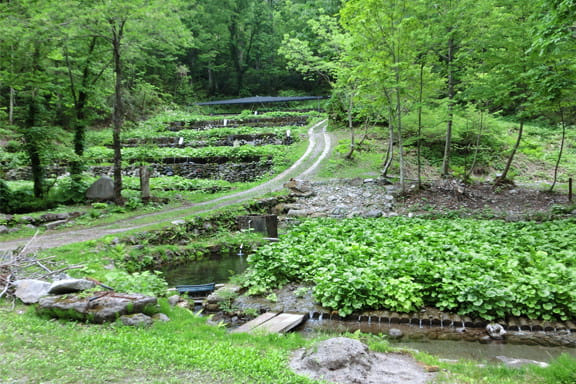
Explore the riverhead, play in the river, catch char, and engage in other river activitiesArrive at your traditional folk-house accommodations in ShiramineEnjoy a mountain-themed Ho’onko ryori feast, featuring plenty of ingredients like rice grown with Mt. Hakusan’s waters, wild plants, vegetables, and mushrooms, for dinner at your accommodations
The vegetarian meal served at the Ho’onko ryori memorial service of Jōdo Shinshū Buddhism Ho’onko. Around Shiramine, seasonal harvests include wild plants foraged and preserved after the spring snowmelt, summer vegetables, and mushrooms in the fall, with Ho’onko ryori being at the center of it all. This mountain-themed feast expresses a year’s worth of gratitude, honoring the blessings of Mt. Hakusan and the people who live in the local hamlets.
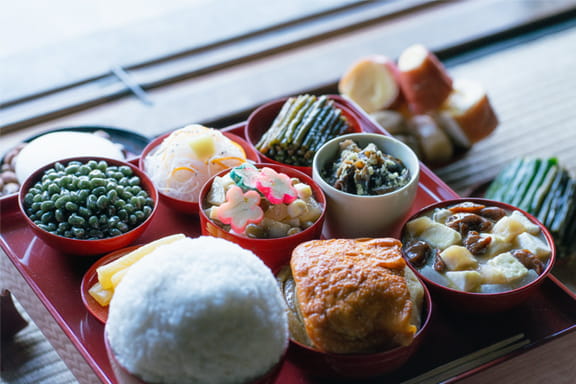
9:00 a.m. | Depart from your accommodationsVisit Ishikawa’s Hakusan Folk Museum, experience traditional dyeing, and mill some rare finger millet to make your own kamashi-iriko for snack time
This outdoor museum offers a glimpse into the lives of people who have lived in harmony with Mt. Hakusan. Six traditional folk houses from hamlets and places deep in the mountains were relocated here in their original states, and you can even go inside them. Experience one aspect of life in a mountain hamlet subject to heavy snowfall by working with traditional vegetable dyes, making a time-honored snack with the Sugihara family—wealthy merchants during the Edo period—and trying some straw crafts.
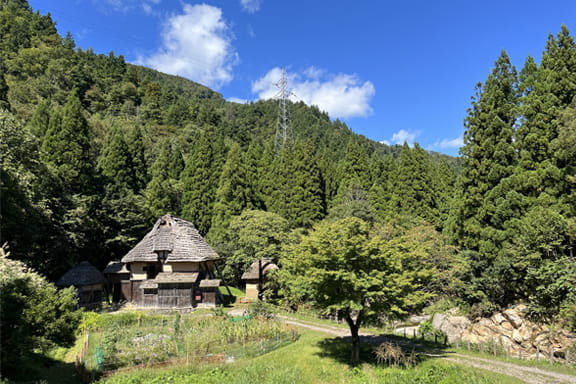
Experience weaving pongee fabric at Ori-no-Shiryokan Hakusan KoboEat lunch in a traditional folk house built during the Edo period
Here you can try making everyday dishes enjoyed by the community. Dishes made with local ingredients such as assorted grains, wild plants, vegetables, and mushrooms have supposedly been consumed in the Shiramine region since the Jomon period (14,500 BCE–900 BCE) and pack rich flavors. You can also dine around a sunken hearth—a rare opportunity to taste a bit of Japan’s traditional way of life.
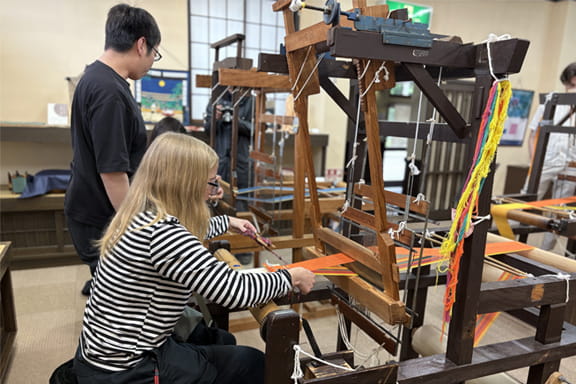
1:00 p.m. | Depart from ShiramineTour and take commemorative photos of the Watagataki Waterfall
This dynamic waterfall has a 32-meter drop and gets its Japanese name from the spray generated by the water as it surges downward, which looks almost like cotton floating in the air. You can just feel the sheer energy of Mt. Hakusan’s snowmelt as it gushes toward the sea. The emerald-green Tedori River flowing through the gorge is another sight to see. Experience this impressive waterfall up close.

3:00 p.m. | Arrive at Kanazawa Station (arrivals and departures to and from Komatsu Airport are also available)
From Nishi-Kanazawa Station to Hokuriku Railway Tsurugi Station (25 mins), then transfer to the bus to Shiramine (1 hour)
From Kanazawa Station to Shiramine by bus (2 hours) or car (1 hour 15 mins)
From Komatsu Airport to Shiramine by car (1 hour)
Shiramine Tourism Association
Telephone Number :
+81 (90)-4686-9238
Telephone Languages :
Japanese
URL :
URL :
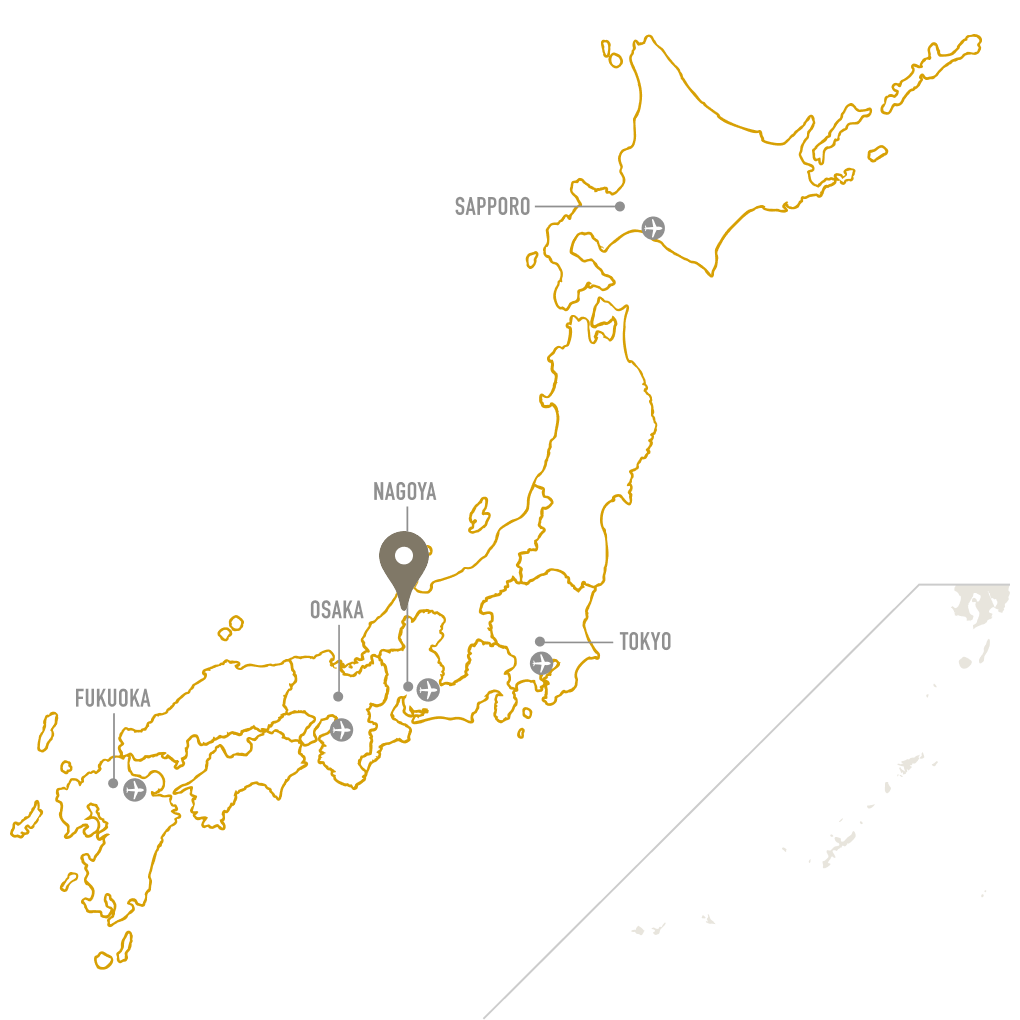
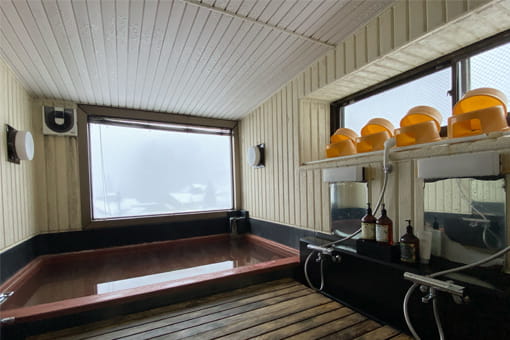
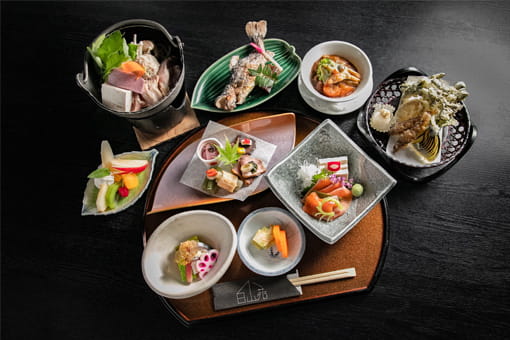
This traditional hot spring inn serves delectable dishes made from seasonal local ingredients, including wild vegetables, river fish, and its renowned hot pot. The inn’s hot spring water is drawn from the same source as ‘Shiramine Onsen Soyu’, a spring celebrated for its skin-beautifying properties. Conveniently located in the village center, Hakusan-en offers guests the chance to explore the traditional townscape on foot and enjoy browsing various specialty food stores. The inn is also a popular base for climbing Mount Hakusan. Don’t forget to greet the inn’s friendly cat as you relax and unwind in your cozy room.

Address :
158-4 Ro, Shiramine, Hakusan-shi, Ishikawa Prefecture
Telephone Number :
+81 (0)76-259-2057
Telephone Languages :
Japanese, English
Access :
1 hour and 15 minutes by car from Kanazawa Station to Shiramine
Check-in :
3:00 p.m.
Check-out :
10:00 a.m.
Rates :
From 14,000 yen per person per night with two meals
Accepted Credit Cards :
VISA/Mastercard/AMEX/JCB
Bedroom :
Private room for two to four persons, lockable, Japanese futons
Bathroom :
Hot spring available (from check-in until check-out)
Toilet :
Western style
Meals :
Breakfast, Dinner
Wi-Fi :
Available
Website URL (Japanese Only) :
Reservation Website URL (Japanese Only) :
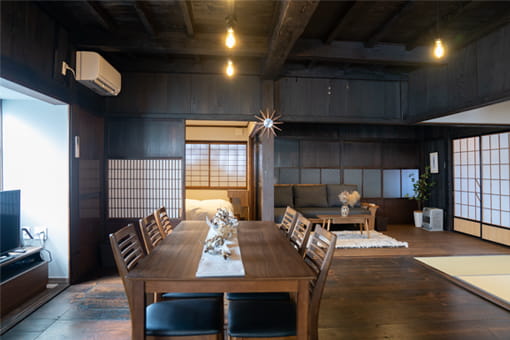
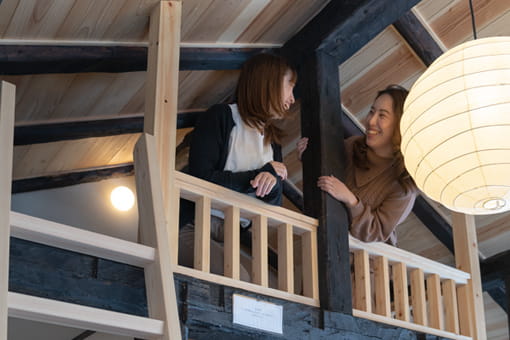
This rental accommodation has been beautifully renovated from an old house that showcases Shiramine's traditional architecture. Reflecting a style unique to snowy regions in Japan, the first floor features wooden walls while the second floor is constructed with earthen materials. The second floor was once used for silkworm cultivation. Guests can enjoy meals at the nearby Hakusan-en inn, which is within walking distance, or at one of the local restaurants. A kitchen is also available onsite for those who prefer to cook their own meals.

Address :
36-1 Ro, Shiramine, Hakusan-shi, Ishikawa Prefecture
Telephone Number :
+81 (0)76-205-6739
Telephone Languages :
Japanese, English
Access :
1 hour and 15 minutes by car from Kanazawa Station to Shiramine
Check-in :
3:00 p.m.–6:00 p.m.
Check-out :
10:00 a.m.
Rates :
From 13,200 yen per person per night without meals, plus 6,450 yen for a plan that includes breakfast and dinner
Accepted Credit Cards :
VISA/Mastercard/AMEX/JCB
Bedroom :
Single-unit rental for up to 10 people, lockable, Western beds and Japanese futons
Bathroom :
Lockable bathroom available, bathtub available (from check-in until check-out)
Toilet :
Western style
Meals :
Available (provided at nearby Hakusan-en)
Wi-Fi :
Available
Website URL :
Reservation Website URL (Japanese Only) :


This late 18th century wooden house in the Important Preservation District for Groups of Traditional Buildings was revitalized as a gathering place for local residents. Also attracting fans from outside the area, Yukidaruma's specialties include udon noodles featuring grated daikon radish and seasonal ingredients, as well as the whimsical ‘Tedori River Dam Curry’. The restaurant also offers banquet-style dining in the evenings.

Address :
75 I, Shiramine, Hakusan-shi, Ishikawa Prefecture
Telephone Number :
+81 (0)76-259-2071
Telephone Languages :
Japanese
Access :
1 hour and 15 minutes by car from Kanazawa Station to Shiramine
Opening Hours :
11:00 a.m.–3:00 p.m., 5:00 p.m.–9:00 p.m.
Closed :
Thursdays *Subject to change – please check before visiting
Cuisine :
Local cuisine, cafe, izakaya
Foreign Language Menu :
Available
Accepted Credit Cards :
None
Website URL (Japanese Only) :
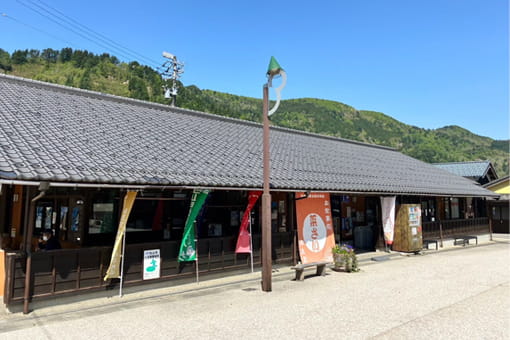
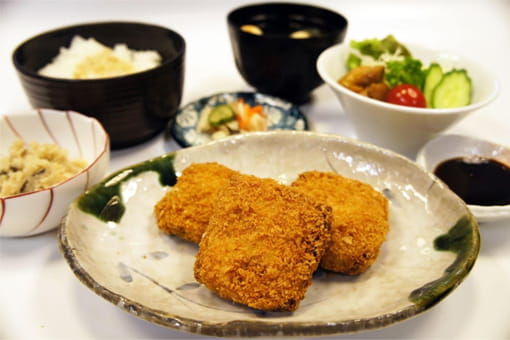
This cafeteria is conveniently located right in front of a hot spring attached to a facility that sells local products. Enjoy delicious soba noodles and rice bowls topped with local ingredients, such as mountain vegetables, firm tofu, and finger millet. Saisai also offers unique takes on classic family dinner favorites like Japanese hamburg steak, ramen, and gelato. The store sells ‘tochimochi’ rice cakes produced in Shiramine, as well as local delicacies made from mountain asparagus, butterbur, and more.

Address :
64-3 Ro, Shiramine, Hakusan-shi, Ishikawa Prefecture
Telephone Number :
+81 (0)76-259-2588
Telephone Languages :
Japanese
Access :
1 hour and 15 minutes by car from Kanazawa Station to Shiramine
Opening Hours :
10:00 a.m.–5:00 p.m.
Closed :
Tuesday, Wednesday
Cuisine :
Local cuisine, cafeteria, cafe
Foreign Language Menu :
Available
Accepted Credit Cards :
VISA/Mastercard/AMEX/JCB
Website URL (Japanese Only) :
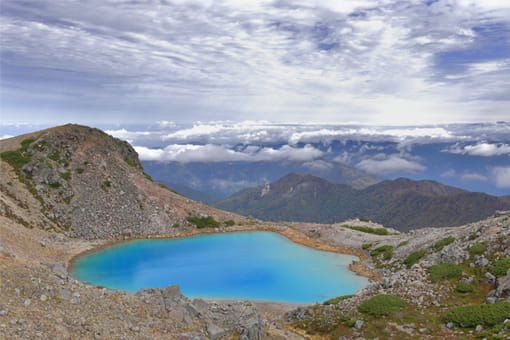

Mount Hakusan is a sacred mountain that has been a site of pilgrimage for 1,300 years. Enjoy a two-day, one-night mountain climbing tour with local guides who live at the foot of the mountain. Highlights include witnessing the sunrise from the summit and immersing yourself in the history, culture, and nature of Hakusan.

Meeting place :
In front of Saisai (negotiable)
Telephone Number :
+81 (0)90-4686-9238(NPO Hakusan Shiramine Nature School)
Telephone Languages :
Japanese, English
Access :
1 hour and 15 minutes by car from Kanazawa Station to Shiramine
Duration :
Two days
Fee :
From 50,000 yen for a group of up to five persons
Languages Supported :
Japanese, English
Accepted Credit Cards :
None
Website URL :
https://yositai2022.wixsite.com/visit-shiramine/things-to-do
Reservation Website URL (Japanese Only) :
Reservations :
Fill in the application form on the above reservation website, call, or email www.shiramine.org@gmail.com
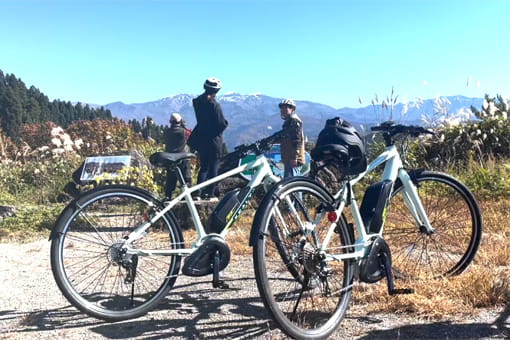

Electric cross bike tours take you to historical and natural spots in Shiramine, making it easy to explore areas that might be difficult to reach on foot. There are four different tours: a ride through the traditional townscape, fishing for char trout in the river, enjoying the spectacular view of Mount Hakusan, and a visit to Ichinose, the starting point for climbing the mountain. Tours run from April to November.

Meeting place :
In front of Saisai (negotiable)
Telephone Number :
+81 (0)90-4686-9238 (NPO Hakusan Shiramine Nature School)
Telephone Languages :
Japanese, English
Access :
1 hour and 15 minutes by car from Kanazawa Station to Shiramine
Duration :
1.5–3 hours
Fee :
8,000–15,000 yen per person for groups of up to three people
Languages supported :
Japanese, English
Accepted Credit Cards :
None
Website URL :
Reservation Website URL (Japanese Only) :
Reservations :
Fill in the application form on the above reservation website, call, or email www.shiramine.org@gmail.com
Hokkaido
Tohoku
Hokuriku/
Shinshu
Kanto
Tokai
Kansai
Shikoku
Kyushu
Okinawa